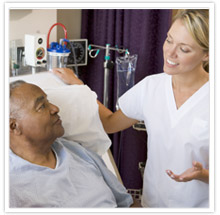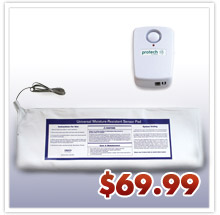|
|
|
|
|
|
|


|
Brush Up on Fall Risk Factors
Do you know which of your residents are most likely to suffer a fall? Can you spot environmental hazards at your facility? The Agency for Healthcare Research and Quality (AHRQ) recently posted a new training module to help nursing home personnel strengthen their fall prevention and management skills.
In the module, the AHRQ notes that there are two primary groups of risk factors: those tied directly to residents and those linked to the environment.
|
|
|
|
They list the following as the biggest risk factors related to residents1:
- Previous falls: If residents have fallen in the past, they are much more likely to do so in the future.
- Diminished strength: Strength is measured by a resident's ability to stand and walk unaided. Residents with diminished strength in their lower limbs are more likely to fall.
- Gait and balance impairments: Abnormal patterns of steps and difficulty maintaining balance can lead to falls.
- Medications: Certain drugs, such as sedatives, hypnotics, antidepressants and benzodiazepines, have been associated with falls.
- Alzheimer's disease or dementia: In general, residents with dementia are both more likely to fall and more likely to be injured in a fall. They are also more likely to fall during the late afternoon and at night.
- Vision impairment: Difficulty seeing clearly is tied to increased fall risk.
Falls can also be caused by problems in the environment, such as1:
- Design problems: Call buttons that are inaccessible, insufficient lighting and floors that are wet, uneven or slippery can lead to falls.
- Lack of space: If rooms are small or overcrowded, residents are more likely to fall while trying to navigate them.
- Obstacles: Items left in crowded rooms or hallways, such as wheelchairs, linen carts, medicine carts and cleaning equipment, can lead to falls.
- Equipment malfunction or misuse: Residents are more likely to fall if the equipment they rely on doesn’t work properly, such as wheelchairs that don’t lock.
- Staffing and organization or care: Inadequate staffing can leave residents at a high risk of falls without supervision.
The AHRQ module also includes guidance on limiting falls that cause injury, responding to falls and a list of additional tools and resources for use in your fall prevention efforts.
Reference
1 Agency for Healthcare Research and Quality. Improving Patient Safety in Long-Term Care Facilities, Module 3. Available at: http://www.ahrq.gov/qual/ptsafetyltc/ltcmod3sess1.htm#Safe. Accessed July 25, 2012.
|
|
|
|
|
|


|
ProMed Video Tutorials: Helping You Get the Most Out of Our Products
We're proud to offer an online library of video tutorials to guide you through the use of many of our most popular products and resources. We regularly add new videos to the site, so be sure to check back often! We currently offer in-service videos for the following items:
- Incontinence products
- Blood glucose monitoring systems
- Fall monitors
- Bladder scanners
We also have a video that walks you through getting the most out of our website, promedsupply.com!
|
|
|
|
|
|
 |
|
|


|
This Fall Prevention System features a Basic Alarm and a one-year moisture-resistant bed sensor pad.
The feature-rich, low-cost Basic Alarm provides unparalleled value and is an excellent entry-level upgrade from string monitors.
Additional alarm features:
- Alarm automatically resets when pressure is re-applied to the sensor pad
- Off/low/high switch
- 0/2 second delay is located inside the battery compartment
- Dual-function battery cover features a snap-to-close design as well as a screw for increased tamper resistance
- Unbreakable stainless steel mounting clip
- Strain relief helps reduce strain on sensor pad cable
- Available with optional protective boot to protect the monitor from accidental drops (600-ALPB)
|
|
|
|
Additional bed sensor pad features:
- Available with one-year moisture-resistant warranty period
- Oversized (10” W x 28” L) to reduce the likelihood of false alarms
- 68” bed sensor cable provides more alarm mounting options
Product pricing is only visible to registered promedsupply.com customers. If you are not yet registered, give us a call at (800) 648-5190 and our Customer Care Professionals will be happy to get you set up.
|
|
|
|
|
|






